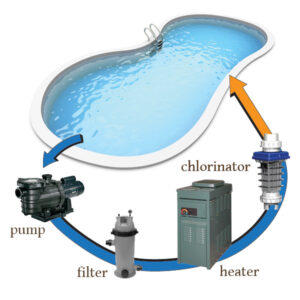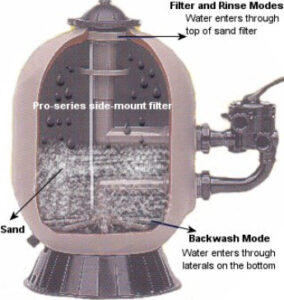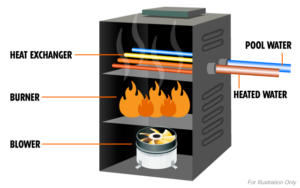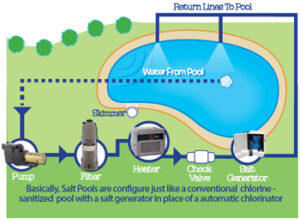Does anyone know how a pool works? I mean, specifically. Do you truly understand the journey of swimming pool water? I will be honest, when I first started working at INYO, I did not fully understand the complete flow process. I mean sure, I knew it started at some point in the pool, then goes through the filter, the pump, the chlorinator, and the heater. But, I wasn’t quite sure where the water went first.
Understanding the journey of swimming pool water is beneficial to pool owners, not just pool technicians. Once you understand the complete flow of water, it becomes much easier to diagnose and repair any circulation issues you might have. Don’t forget, without proper circulation, it is impossible to keep your pool healthy.
The Journey of Swimming Pool Water

Conceptually, pools are identical. In short, the idea is to pump water in a continuous cycle from your pool through your pool equipment and back into the pool. This constant circulation plays an important part in keeping your water healthy, but arranging your pool equipment incorrectly can have dire effects on your pool water and pool equipment.
Does the water flow through your filter or heater first? And, where exactly does the water flow from in the pool? Let’s start at the beginning.
1. Water Inlets
Water inlets are any pool suction points where water flows from your pool back to your equipment for circulation. The majority of pools we encounter have two different types of water inlets: main drains and skimmers. It is not uncommon to have multiple main drains and skimmers. During normal operation, water flows through your filter from your main drains and skimmers.
Most main drains are constructed at the lowest point in your swimming pool so that the entire pool slants towards them. This is how most of the debris and dirt at the bottom exit your pool. Main drains create a strong suction that’s proven to be a health concern. Federal statutes now require anti-vortex covers for each drain. This prevents hair and limbs from getting caught in the plumbing.
 Skimmers, on the other hand, work the same way as main drains except they suck water from the very top of the pool. Floating debris typically exits the pool through your skimmer. The floating weir on the skimmer swings in and out, acting as an inlet passageway. The weir allows a very small amount of water in at a certain time. The goal is to ‘skim’ the surface level to catch debris effectively.
Skimmers, on the other hand, work the same way as main drains except they suck water from the very top of the pool. Floating debris typically exits the pool through your skimmer. The floating weir on the skimmer swings in and out, acting as an inlet passageway. The weir allows a very small amount of water in at a certain time. The goal is to ‘skim’ the surface level to catch debris effectively.
The water flows through the strainer basket, catching any larger debris, such as leaves, bugs, and twigs. This is the first level of cleaning your water goes through. In addition to the main inlet, your skimmer system has a secondary (equalizer) line leading to a drain below the surface. This line keeps the skimmer from drawing air into the pump system if the water level drops below the level of the main inlet. When you think about it, there are a lot of suction within a swimming pool system. In a safe pool, there is always multiple main drains and skimmer drains your pump can pull water from. This eliminates the suction of any blocked drain,
After your pool water makes its way through the various drains, the water flows on to the pump and filtering stage.
2. The Pump
The beginning of the continuous cycle starts with the pump. Once you turn on your pump, it draws water from both the pool and the skimmers, delivering water to the pump and motor. Once the water reaches the pump, it passes through an initial filter, or what we call the strainer basket. This removes most debris from the water prior to sending it through the pump housing
3. Filtering Stage
Your pool’s water journey begins in the pool, flowing through one of your drains to your pump. Just before it flows into your pump, the water passes through a strainer basket that catches leaves and other large debris that may clog up the pump. Next, the water flows into your filter.

During filtering, dirty water from the pool comes in through the filter’s inlet pipe. This pipe leads to the water distribution head inside the tank. Gravity pulls the water through the filter, catching the dirt within your media. At the bottom of the tank, the filtered water flows through the unit and out the outlet pipe.
Over a period of time, the filter becomes saturated with dirt and requires a cleaning. This process is known as backwashing. In short, backwashing is simply removing dirt by reversing the flow of water. During normal operation, pool water enters the filter at the top and flows out of the base.
Once your water is filtered, it either flows to your heater or your chemical feeder. Although not every pool owner owns a pool heater, it’s very important that if you do, plumb the heater before your chemical feeder and install a check valve. The reason you need a check valve if you have a pool heater and a chemical feeder is that the concentrated chlorine in the plumbing near the heater will damage and corrode the heat exchanger. Sometimes this is overlooked when pool owners upgrade their pool systems with a heater.
4. Through the Heater

Once your water leaves your filter, it flows through your heater. Although not all pools have heaters, they are becoming an increasingly popular add-on. The water passes through the heat exchanger, located in the fire box above the flame bed.
Heat transfers to the water via combustion and the heated pool water flows back out of your heater to either your pool or your chemical feeder.
5. Sanitation

Although your filtering system does most of the heavy lifting in terms of keeping your water clean, you still have to sanitize your water in order for it to be effective. Dangerous pathogens and bacteria thrive in water and a pool filled with untreated water is an ideal place for carcinogens to form. If you do not own a heater, then once the water leaves your filter it flows through your sanitation device. You can sanitize your pool in many different ways including a salt water generator, chlorinator, chemical feeder, or mineral purifier.
For chemical feeders, pool water is directed through the feeder where sanitizer is displaced into the pool water and sent back to the pool via the returns. Mineral purifiers are usually plumbed in line within the circulation plumbing. Inside the purifier vessel is the cartridge that contains the purifying minerals. No matter which sanitation device you choose, it is always the last piece of equipment your water flows through before returning back to the pool.
6. Returns
Pool water returns are places in the pool where water comes back in after circulation. Most pools have two or three different returns and it forms the end and beginning of pool water’s journey.









Leave a Reply